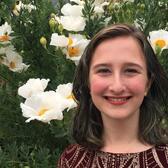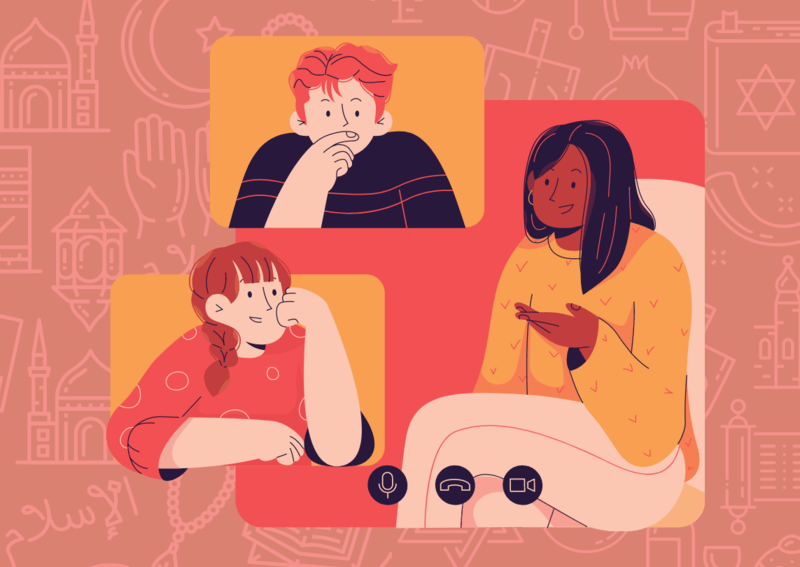Lessons on Interfaith Intersectionality during a Pandemic
I sang in the top center row of the Zoom call—at least that’s how it appeared on my screen. Prayers that once burst from my lungs to join the voices of my community members now tumbled out, clashing with the leader’s pronunciations during services (or as they are affectionately called now, “Zervices,” since they’re on Zoom). I kept my mic muted, lest anyone else hear the disruption of religious sanctity. The soft laughs that punctuated the transitional silences let me know it wasn't just me feeling this slight awkwardness. After all, religious traditions weren’t built with Zoom in mind.
Because of the pandemic, once intimate, in-person religious practices have been relegated to thirteen-inch screens serving as portals for faith and community. There are now Zoom b’nai mitzvahs and Shabbats, Zoom Sunday services, and Zoom wasilas: Each a means of connecting with one another as we grapple with a new, but everchanging, socially-distant reality.
When Covid-19 destabilized the world we knew, religion became a comfort for many. Approximately one of every four Americans reported that their religious beliefs deepened as a result of the pandemic, according to the Pew Research Center. Pew also noted that 91 percent of religious people surveyed reported that their congregations had moved online, suggesting that in-person faith communities are not all that binds us to religious practice.
While there are certainly downsides, shifting these ceremonies online has also had major benefits. As a member of my local interfaith community, I’ve found that Zoom has actually opened up many opportunities for me. The transition to online worship has made it possible to engage with folks hours or even states away. Physical barriers of geography melted. People previously excluded from religious services, such as those lacking transportation or with disabilities, are now able to attend and participate in services. Additionally, online attendance is no longer stigmatized. With online events the new norm, more speakers—and perspectives—have also become visible.
Participation in interfaith events also shifted. While people before lockdown sometimes felt intimidated by the social nature of interfaith gatherings, Zoom provides the ability to participate at one's own comfort level. This is especially true for women, who might have previously felt excluded from the interfaith community, given the historically patriarchal nature of most religions.
As a local interfaith coordinator for my college, I noticed this phenomenon in event RSVPs. Online events, such as a talk with a researcher in Islamic and Judaic studies, regularly drew audiences that were predominantly women. For in-person events like a havdalah/iftar, women often made up 40 percent or fewer of the attendees. Interestingly, a greater proportion of men would RSVP and then not attend online events, while a greater proportion of women would RSVP and then not attend in-person events. While this evidence is anecdotal, it suggests Zoom offers amenities that in-person interactions do not: space to be heard, comfort, and safety.
As a woman, I have periodically felt my own voice drowned out at events by men “mansplaining” or commandeering conversations. But on Zoom, it’s clear when one person dominates and prevents others from being heard. The chat function in Zoom also allows for participants to type their thoughts, or to comment “I want to speak next,” so it’s apparent that a voice has been missed. Zoom enables moderators to include those who might not otherwise speak up—it is much easier to take things slowly, be deliberate, and make sure everyone has a chance to speak.
Zoom also eliminates social pressures about appearances. While women typically feel greater pressure to present a socially acceptable facade, that burden is alleviated as Zoom allows participants the option to turn off their cameras or dress in comfy clothing below camera view. And let’s face it: with the two inches of screen that gallery mode provides, fashion choices are increasingly irrelevant. The barrier to entry that is established at in-person functions is thus removed by online events, allowing women to join as they are without need for significant effort.
Additionally, the growing Black Lives Matter movement has given rise to an increased awareness about intersectionality in interfaith circles, which are historically diverse. There is a newfound understanding that in order to confront white supremacy, racism, and sexism, and bigotry in its many forms, we must first unpack how we relate and contribute to those issues, and then work on how to change. With the intentionality of Zoom, we are able to deliberate on these issues of systemic inequities and privileges in a more intense and thoughtful way than we were before the pandemic, with a wider audience and wider range of speakers. The coronavirus has pushed us to be more thoughtful about which events and conversations we really care about and who we are including and unintentionally excluding from our circles. We needed the world to stop, both literally and metaphorically, for us to recognize the many implicit biases in our communities and how to address those.
While I am excited about the reopening of the United States, I urge reflection during this transition. As much as we have lost from Covid-19, we have also learned, and we can’t afford to return to the way things were before. The Interfaith community has grown to be about more than just celebrating different religions and cultures. It’s now a space in which nuance and intersectionality play key roles. In our post-Covid world, let us not lose this commitment to inclusion—we have so much to gain in spaces where all voices are heard and everyone is not just invited, but welcomed.








Thanks for sharing these thoughts. I haven't been part of a religious community for many years. Your essay made me consider the possibility that Zoom might be a way to transcend some what was problematic and reconnect with what is profound.